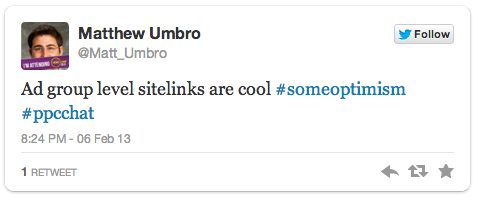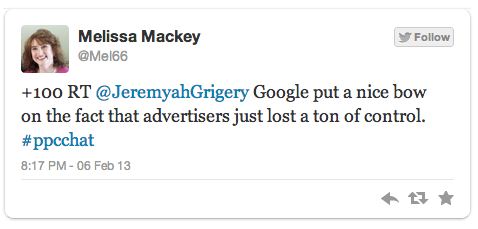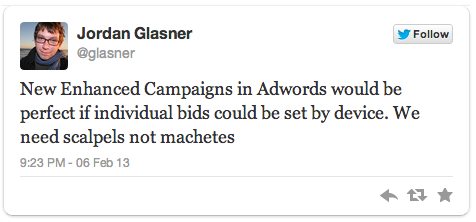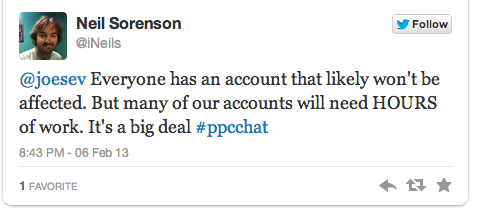Google’s Enhanced Campaigns Inspire Love, Hate And Hope For The Next Version
Tensions were high in the pay-per-click world yesterday, as marketers held their collective breath waiting for news of what were rumored to be “big changes” from Google AdWords. Indeed, it was big news — the launch of Enhanced Campaigns, which let marketers combine separate desktop and mobile campaigns into one, with a variety of implications. […]
Tensions were high in the pay-per-click world yesterday, as marketers held their collective breath waiting for news of what were rumored to be “big changes” from Google AdWords. Indeed, it was big news — the launch of Enhanced Campaigns, which let marketers combine separate desktop and mobile campaigns into one, with a variety of implications.
Following, thoughts from marketers about what they like, what they don’t like, what needs to be done now, and what they’d like to see in future releases. (Note: This is a significant update with a lot of inter-related changes, so we can’t hope to get to everything here, but stay tuned as we continue to cover the implications.)
The Good Stuff
Marketers acknowledge that we’re living in an always-on, multi-device world which warrants a different approach to reaching potential customers. It also makes sense that one would want to deliver different creative to people depending on the context — whether they’re on-the-go with their smartphone, or multi-screening on the couch with their tablet.
And, no one is arguing that the current process of deploying and managing multiple parallel campaigns to deal with this is particularly fun or efficient.
“Until now, the process for segmenting […] traffic for bidding and ad copy purposes has been needlessly cumbersome, requiring advertisers to duplicate whole campaigns several times over. Enhanced Campaigns will help in that area,” said Mark Ballard, research analyst for the RimmKaufmann Group.
Other new capabilities get praise from Jeremy Hull, director of search at iProspect: “Many features are excellent additions to AdWords functionality; the bid boosting, sitelink management, and new reporting features will help advertisers evolve their view of paid search more in line with that of an omni-channel strategy.”
Hull is referring to new functionality that will change up the way ad extensions work, which Google calls “Upgraded extensions.” First, extensions can now be created either at the campaign or at the ad group level. Additionally, marketers will have more control over when they appear — by device and by time of day. For example, a marketer may want to display a call-to-action on smartphones designed to drive users into retail locations — but only during the hours that the retail location is open.
Bricks-and-mortar companies will also benefit from another element — the ability to bid differently on different geographies within the same campaign. For example, a coffee shop might want to bid higher for potential mobile customers within a mile of the establishment, a little lower for those within five miles, and even lower for those further away.
Reporting on sitelinks will also be available at a more granular level. Marketers will be able to see performance data for each individual sitelink, and fine tune accordingly. Additionally, each sitelink within a set will be approved individually; so, if 5 sitelinks were submitted and only 4 approved, the approved ones could go ahead and run.
One key for these upgraded extensions — to use them now (as soon as your account gets the upgrade) you need to create an enhanced campaign and then click the Ad Extensions tab to create the extensions. If you do it in any other way, you won’t get the upgraded functionality.
The Bad Stuff
It’s not surprising that the main concern from marketers about the change is a fear of the lack of control. As with many recent updates, Google seems to be trying to make things easier and simpler — especially for smaller marketers — and, in the process, the company sometimes ditches some of the fine-tuning capabilities that more sophisticated marketers are taking advantage of.
“This is an example of Google deciding what is best for the advertiser. However, in this case they’re not just opting you into a setting by default, they’re removing the option of opting out,” iProspect’s Hull said.
The biggest and most important gripe is the grouping of tablets with desktops for bidding purposes. This tablet/desktop bid is the “default” bid, and the smartphone bid can be a (positive or negative) multiplier of that. This effectively will bring to an end some of the bargains that marketers were getting on tablet traffic, boosting Google’s revenues in the process.
“By lumping the higher performing tablet traffic in with desktop traffic, RPS (revenue-per-search) will increase for Google as CPCs increase on the combined desktop and tablet traffic. This, presumably, will address Google’s mobile monetization gap as an increasing share of searches is coming from tablets and smartphones,” Adobe’s Bill Mungovan writes in a blog post.
Susan Waldes, senior client services manager at PPC Associates, agrees, saying, “Though search behavior and click behavior is pretty similar per device [desktop and tablet], the types of conversion actions completed vary immensely. A quick email capture on tablet is similar, but what if you are pushing a software download as your conversion action? Does this mean you can’t opt out of tablets altogether?”
Indeed, it appears that you can’t opt out of tablets, nor can you opt out of desktops. There’s no way to conduct a mobile-only campaign. Though some speculated that one might get around this by bidding, say, a penny for desktop/tablet and multiplying that for mobile, marketers are limited on mobile. They can multiply by -100%, or in the range between -90% and +300%. That means someone would only be able to bid up to $3.00 if desktop/tablet was bid at a penny. Great, if that works for you. If not, you’re out of luck. (With other parameters, like locations, days, times, and any ad group-level targeting methods, the acceptable multiplier range is between -90% and +900%.)
What To Do
The bottom line, whether you like the changes or not, is that transitioning to the new campaign structure is going to take work — lots of work.
First, there’s the need to develop new best practices for structuring accounts and campaigns, as well as coming up with creatives. And, third-party tool makers will be doing a lot of programming. Keith Wilson, VP of marketing strategy for the Search Agency puts it like this:
[Our company] anticipates evolving account structure best practices, which are the FOUNDATION for driving search performance. Technology and tool providers will also need to adjust data schemes to extract performance by creative targeting settings on their backend. Additionally, creative teams will have to evolve best practices for advanced targeting and performance measurement using new data points not previously available.
Of course, beyond the planning work will be the actual inputting of new campaigns and combining of desktop and mobile campaigns into a single campaign — no simple task.
Google says it’s stepping up education and support to help marketers cope with the changes. It has developed an “upgrade guide” PDF and is planning a series of webinars. More blog posts are also forthcoming, and support personnel will be on duty, as well.
Of course, some marketers are opting to sit back, do some research, and wait while others explore the new features and report on their successes and failures. The automatic conversion of campaigns is still a few months off, after all.
Hopes For the Next Release
If you’re a product developer, all the complaints could be thought of as “feature requests.” For example, Google says things like optimization for the new conversion types are already in the works.
Mark Ballard of RKG is advocating for more granular device data. “We love to dig into our performance data to find those niche segments that perform differently and then act upon that information,” he said. “iPad users are different from Android tablet users and we see that in the numbers. Unfortunately, it looks like we will not have that level of control or some of the other functionality we’d like to have with the initial launch of Enhanced Campaigns.”
The ability to break out tablets and desktop would likely be another frequent request. And, more will certainly be forthcoming as marketers get their hands on the new interface and discover the capabilities — and limitations — of the new Enhanced Campaigns.
Related stories




